Debate rages in the amp builder world about how to do heater wiring, here's my take on the matter.
The important thing to achieve is to have the two ends of the AC supply placed so as to avoid creating an electric field that surrounds the grid connections. Every variation I've seen involves laying the heater cables flat against the chassis but this inevitably makes some part of the circuit surround the socket terminals. The solution I settled on was to run the supply standing off the chassis and angled down into the centre of each tube socket. These need a few cables ties as pictured but will keep electric fields as far as possible from the signal electrodes.
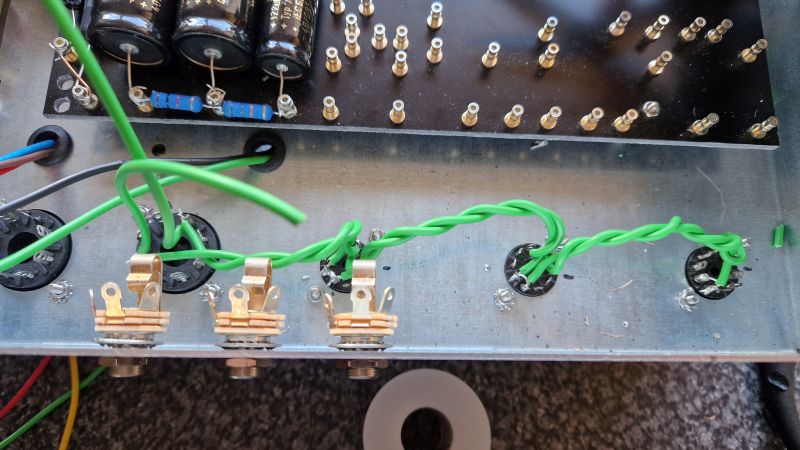
As the 9-pin sockets need to be chained together, a bit of planning goes a long way when attaching the wires. First step is to place (not solder) a wire bridging pins 4 and 5.
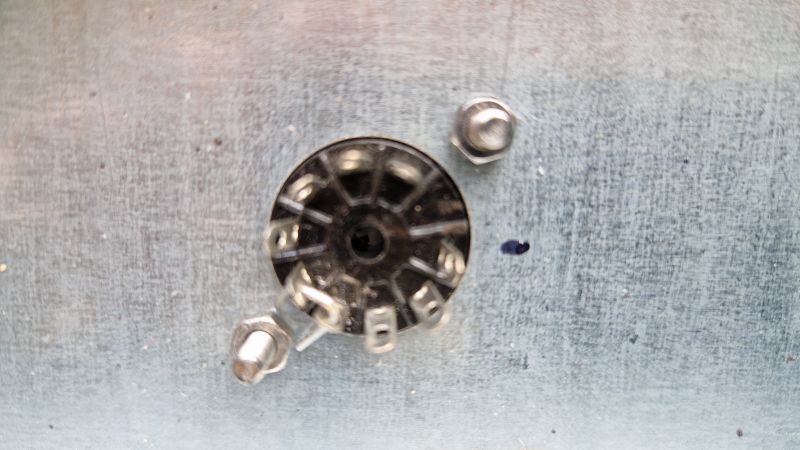
Then add a supply wire to pin 5 and solder that terminal only. Solder two wires into pin 9 to chain the sockets together, add the wire to pin 4 and run this to the next socket in the chain.This avoids trying to thread cable into already-soldered terminal holes and makes for a very neat set of heater wires.

Here's a thing I've wanted to do for a very long time! A few shipments of vacuum tubes, turretboards, faceplates, capacitors, carbon resistors and other components means I'm embarking on an amplifier kit build. This is a Supa Deluxe kit from Modulus Amplification, a souped-up version of a Fender Deluxe with a full tone stack and a master volume.
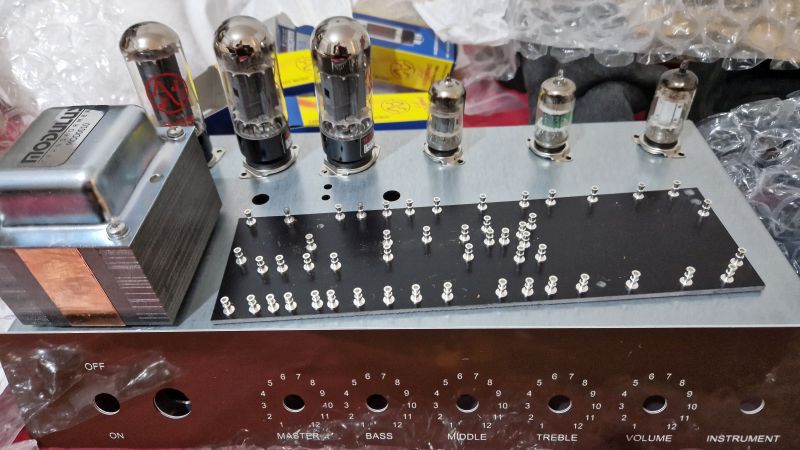
The chassis has a cutout for three preamp tubes but the schematic only calls for two so I'm wondering if this could be adapted to add a reverb or maybe a valve-driven effect loop copied from a Mesa Boogie circuit.
I haven't built a turretboard amp before so this is really challenging at first but very much more satisfying than just populating a PCB. The important thing is to wrap all the component leads in the same direction around the turrets to avoid partially unwinding the previous components.

Still waiting for Modulus to build the tweed headshell cabinet. It may even arrive before I finish wiring this thing together.
An eBay special has arriived - a Marshall DSL20 head in condition best described as "gigged". Seller told me it had some crackling noises and probably needed new output valves. Consequently it was on the market at a ridiculously low price so I had to reach for the credit card. Here's what arrived ...
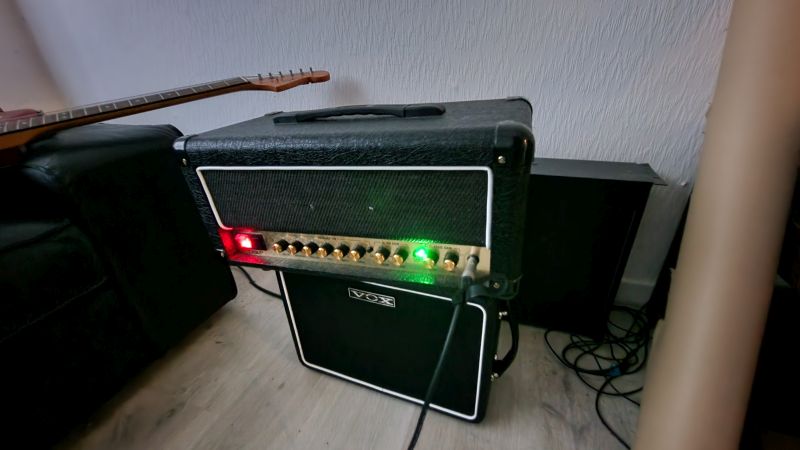
First rule with a possibly dodgy amp is DON'T PLUG IT IN. Instead I removed the chassis screws and did the usual safety checks on the innards, looking for things like bad solder joints or leaking capacitors. Everything looked fine but fuck me, Marshalls are not built the way I remember. All the valves are mounted on a PCB, including the EL34 output tubes that run a fair amount of plate current and generate a considerable amount of heat so this may be a problem in the future. Also concerning to see just how small the filter capacitors are on this amp. Where you would expect to find axial caps on a tagboard, here the capacitors are radials about half the size of "normal" ones and mounted straight onto the PCB.

Even weirder was the reverb unit, a small DSP board slotted vertically into the main PCB. Not a great sound but better than nothing and rather surprisingly for a low-price amp there is an effects loop so it'll take a Strymon or an EvenTide. Or maybe even the BOSS GT-1000CORE. To be determined at a later date. For now this looks like a great little amp to take to jam sessions.
Anyway, a pair of new ElectroHarmonix EL34's have worked wonders and while it's not a classic Plexi sound, it's near enough for just under £210. Just a bit depressing to see Marshalls churned out from a factory in Vietnam rather than built with care in Milton Keynes.
It's been a lot of work but the modified Casio MG-510 guitar is now reborn as The Casiocaster. I added a set of Fender tuners and a Fender tremolo unit, both far better than the slightly cheap hardware fitted as standard. A huge amount of work but it's all paid off in the end. The noiseless DiMarzio pickups are a vast improvement on the iron-loaded HSS pickups it came with and the ability to drive the BOSS SY-1000 synth directly makes this a pretty incredible guitar.

Would I recommend doing this to a guitar? Not unless you can fins a cheap Casio like I did. Fitting a Roland GK kit is quite an undertaking even in a guitar with cavities already routed out like in the Casiocaster and a nightmare in a standard Stratocaster. Trust me, I've done this on a Fender Stratocaster in the past and it's not something I would want to do again. Just buy an MG-510 and a router, get a custom pickguard made and while I wouldn't call it straightforward it's a lot easier than digging into a Fender guitar. And forget it entirely on anything that isn't vaguely Strat-shaped.
Video to follow!
Slightly potato quality video but you get the idea. This is the Fender GC-1 Stratocaster again triggering the SY-1000 with the GK pickup, this time with the magnetic pickups running through the BOSS GT-1000 processor with the Eventide ModFactor, TimeFactor and Space. Didn't get round to using the PitchFactor on this one but it sounds spacey enough already.
By the mid-1980s Fender were in a mess. Declining quality, cheap imports and the far better build quality of Japanese Fender instruments had damaged public perception of the CBS-era guitars. The buyout by William Shultz and other investors and the appointment of Dan Smith started the turnaround in fortunes that would restore confidence in the company and return them to the top of the sales charts just in time to catch the drift away from music driven by Gibson-esque humbucker overdrive and towards cleaner single-coil guitar sounds that sat well with the horrible FM synthesisers that would dominate the pop charts for the rest of the decade. And that's when I bought this ...

The introduction of the US Standard Stratocaster in 1987 is widely reckoned to have saved Fender and my 1987 or 1988 (can't remember!) guitar is one of the very best examples of their output at this time. It's an "EE serial" - supposedly "European Export" although I can't find any definitive evidence that this is what the letters mean. I've owned and played a lot of guitars over the years but I've never found one as good as this. It's done thousands of gigs and recording sessions and never failed me. The bridge pickup has been replaced by a Seymour Duncan Alnico Pro II and it's had a refret with massive stainless steel frets. That finish is called gun metal blue, only used in the late 1980s and now only available from Fender Japan or Fender Custom Shop so be prepared for some wallet pain if you want a replica. This is on the "never selling" list. In fact it's probably going in the ground with me.
Well, it finally happened. I've got a new toy and it's magnificent.

I've had my eye on one of these for a long time so when this popped up on Reverb at a bargain price I just had to throw caution to the wind. I've used the BOSS GP-10 for many years but the synth sounds on that unit are slightly disappointing, tending towards the farty monosynth and grainy wavetable ends of the spectrum. The SY-1000 is a big improvement, still not as great as a dedicated keyboard synth but really impressive nonetheless. Tracking is superb and while it is still capable of the odd bum note if you get sloppy it still responds to subtle and not-so-subtle playing. It's already connected to my pedalboard over USB MIDI so things like delay times, slicers and even synth LFO's run in sync with MIDI clock. Video demo to follow. And no, I haven't tried plugging it through the Eventide pedals just yet but it's only a matter of time.
Quick late night noodle to test some of the pedalboard controller functionality. This uses the RC500 looper as a master MIDI clock and the guitar signal goes
- BOSS GT-1000 CORE with a compressed stratty sound
- Eventide Pitchfactor for the weird harmony stuff
- Eventide Modfactor with a bit of phasing
- Eventide Timefactor tempo-synced delays
- Eventide Space to add a bit of spring reverb on top
- BOSS RC500 looper doing the drum sounds
All done live in one slightly ropey take so there's the odd fuckup with the tricky timing and the harmoniser gets confused when it hears more than one note at once so maybe I need to upgrade to the Eventide H90.
WARNING: Intensely techy nerd post, feel free to skip this one
Right then. The ESP32 microcontroller was a non-starter. MIDI over USB just wasn't working so we're on plan C now, using WebMIDI in the browser and wonder of wonders. it works surprisingly well. There's a bit of configuration hacking to do in order to enable WebMIDI in the browser but then it's all Javascript callback functions, a shitload of modules and classes and a CSS felxgrid front end. While that has fored me to relearn a lot of web scripting skills it seems to have been worth it as this can now do MIDI clock, program change and controller change. I would have liked some facility to process clock bytes without buffering but you can't have everything. Maybe I'll look into handling those in another thread.
Other planned development includes using IndexedDB to handle program changes and patches but that's a long way down the road. Runs acceptably well on a Raspberry Pi but the tricky touchscreen might mean I just shift this all onto a laptop running Ubuntu.
On the bench this week (and next week and probably the week after) is a Squier Jazzmaster neck that I bought for refretting practice. This has turned into quite a task for a couple of reasons. I've gone with huge stainless steel frets that are really difficult to work with, requiring a lot of force to cut, shape and polish but the task is further complicated by the way the fret slots are cut on this neck. The slots don't extend all the way across the board, making it look from the side like a continuous piece of "rosewood" (actually Indian laurel on this neck) so I can't just cut the frets overhanging then hammer new ones in. Instead the fret slots have to be recut using my shiny new fret saw from Crimson Guitars.
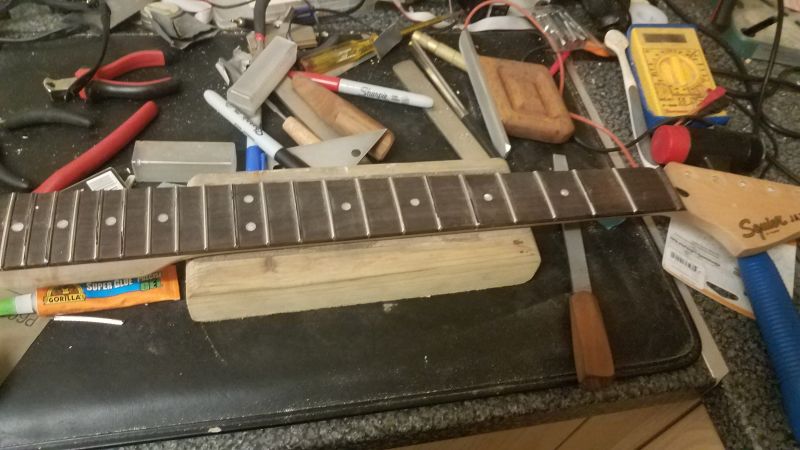
After that it's fairly plain sailing, getting the fret ends flush to the board before bevelling, levelling, crowning and endless sanding and polishing. I think we're about 70% of the way through this job, allowing for a break while I had eye surgery again but I'm pretty pleased with progress so far. The neck will eventually get a set of budget tuners, some second hand Squier hardware, a Mustang bridge and a body kindly donated by my brother. If all that goes according to plan then I'll even throw some money at nice pickups. Always wanted a Jazzmaster, soon I should be playing surf music with the best of them.